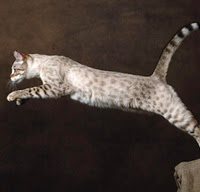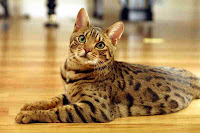Cat Personality
 Bengal may look like a wild cat, but breeders that the Bengal cat is a kind of gentle and docile as a house cat true. Bengals fans, the cats as playful, sociable, energetic and have to describe a good dose of curiosity and cats want to be involved with their families. The water does not scare you, sometimes take the family to swim, because it is on their terms.
Bengal may look like a wild cat, but breeders that the Bengal cat is a kind of gentle and docile as a house cat true. Bengals fans, the cats as playful, sociable, energetic and have to describe a good dose of curiosity and cats want to be involved with their families. The water does not scare you, sometimes take the family to swim, because it is on their terms. Although cats to show quality, or four generations (F4), leopard cat, down from earlier generations of Bengal as pets, so it is important to know what you are getting the acquisition of Bengal Cats Pls. For a second generation (F2) or third generation (F3) of Bengal, make sure the color is missing character problem.
Cat Breed Traits
 Bengal spots are more horizontal than in a random configuration or striped aligned. Rosettes in an arc around a red center is the next most preferred. The emphasis on the contrast between the spots and the background color, the edges are sharp and clean design to paint for a show quality. The marbling, the markers are derived from genes marbled, but the general appearance is random, what impression of marble.
Bengal spots are more horizontal than in a random configuration or striped aligned. Rosettes in an arc around a red center is the next most preferred. The emphasis on the contrast between the spots and the background color, the edges are sharp and clean design to paint for a show quality. The marbling, the markers are derived from genes marbled, but the general appearance is random, what impression of marble. Bengals often have a gene, the fake dress is iridescent light, and with hot ice. Three recessive coat variations have been developed: the snow leopard, marble, marble and snow. These species are still relatively rare.
History - Bengal cat breed?
The Bengal breed was created as a hybrid of man-made Asian leopard cat and domestic cat. The leopard (Felis bengalensis) is a cat-size population of South Asia and is considered one of the most modern types of cats in the nature of the common ancestor of the cat family.The Bengal is a domestic cat, except for older eyes, pause, distinctive mustache, long legs and bright spots of the leopard. In fact, it looks like a miniature leopard. Bengal began his journey into a recognized breed in 1963, Paul breeder Jean Mill of Covina, Calif., has bought a female leopard cat from a pet. At that time, the leopard cat be purchased in the United States, but today it is illegal to sell them. He was not trying to create a new breed of cat to a single wild animal.
A few years later, Mill thought that the cat seemed to be alone, so she has a cat in a cage to keep him company. They did not expect a romantic relationship, but surprisingly produces Mills in 1965, the leopard his cat litter.
A kitten from the litter survived, a hybrid female named Kin-Kin mill. Moulin contact Cornell University College of Veterinary Medicine in Ithaca, New York, for advice on how to manage the hybrid was, and probably at no cost, Kin Kin was infertile. This proved to be wrong. Chin-Chin and his father developed and produced two kittens. One was black and had inherited the temperament of the wild leopard cat, denied approaching anyone. The other, a man has seen, has inherited the sweetness of a house. After careful consideration, decided to become one of the intersections of the mill, that the situation in the leopard cat to reproduce claim. Mill was dismayed by the situation of orphaned leopard cat boy by hunters and sold to American pet stores. Generally cats in zoos Paul ended the pups have grown to maturity and restoration of their wild ways. Mill was found for the American market with an acceptable substitute.
In the first breeding of leopard short hair cat, kitten infertile men have human resources, as is the case with many hybrids. Women were the personnel resources, the human resources normally fertile males and young animals in subsequent generations. But many of these pups have grown with the temperament of the first hybrid cat nerves is uncertain, similar to their wild relatives. Only after the cats were the source person several generations away from the leopard cat has become predictable temperament Bengals.
The standard for the Bengal, unlike other breeds of cats, including a description of the ideal temperament of the cat, he described it as a. Sure, attentive, curious and friendly Any sign of a challenge disqualifies the color to avoid the problems of temperament must be maintained in the breed. This policy requires some cats Bengal's have a high at least four generations to ensure a docile temperament.
However, a number of associations of Bengal is still is as the party crashers in the cat fancy cocktail. The CFA does not accept, the savage races in the blood, and only five organizations (TICA, CCA, UFO, TCA, and CFF) let the Bengals to display. Bengals CCAC accepts registration but not in bedrooms allows you to play because of concerns about the temperament of the breed. Reported concerns include extreme shyness, aggressiveness (Invite Several judges resource problems), and a basic distrust of humans and animals.
Copyright © 1998 by Barron's Educational Series, Inc. based on
ENCYCLOPEDIA OF CAT BREEDS by J. Anne Helgren.
ENCYCLOPEDIA OF CAT BREEDS by J. Anne Helgren.
No comments:
Post a Comment